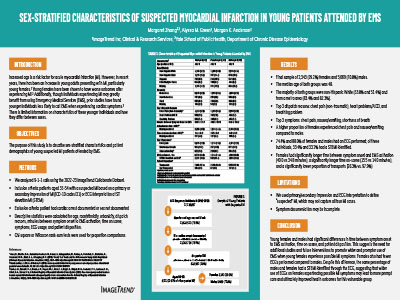ABSTRACTS
Sex-Stratified Characteristics of Suspected Myocardial Infarction in Young Patients Attended by EMSAuthor: Margaret Zhang | | Associate Authors: Alyssa M. Green MS, Morgan K. Anderson MPH
Introduction: Increased age is a risk factor for acute myocardial infarction (MI). However, in recent years, there has been an increase in young adults presenting with MI, particularly young females. Prior studies have found young individuals less likely to call EMS when experiencing cardiac symptoms. There is limited information on characteristics of these younger individuals and how they differ between sexes. The purpose of this study is to describe sex-stratified characteristics and patient demographics of young suspected MI patients attended by EMS. Methods: We analyzed 9-1-1 calls of suspected MI using the 2022-2023 ImageTrend Collaborate dataset. Included were patients aged 35-54 with a suspected MI based on a primary or secondary impression of MI (ICD-10 codes I21) or ECG interpretation of ST elevation MI (STEMI). Patients were excluded if cardiac arrest was documented or if sex was not documented. We calculated descriptive statistics and chi-square or Wilcoxon rank-sum tests for proportion comparison between the populations. Results: The final sample consisted of 2,343(29.2%) females and 5,669(70.8%) males. The median age of both groups was 48(IQR: 9). The majority of females and males were non-Hispanic White(53.8% and 51.4%) and from a metro area(83.4% and 82.3%). The top three dispatch reasons for both females and males were chest pain (non-traumatic) (55.2% and 52.0%), heart problems/AICD(7.0% and 7.7%), and breathing problem(8.1% and 7.1%). There was a higher proportion of females experiencing chest pain(73.2% vs. 72.3%), and nausea/vomiting(9.7% vs. 7.0%). 74.4% and 88.0% of females and males had an ECG performed; of these individuals, 33.4% and 33.2% had a STEMI identified. Females also had a significantly longer time between symptom onset and EMS activation(40.0 vs. 34.8 minutes), had a significantly longer time on-scene(15.5 vs 14.0 minutes), and had a significantly lower proportion of transports(96.3% vs. 97.9%) compared to males. Conclusion: Young females and males had significant differences in time between symptom onset to EMS activation, time on-scene, and patient disposition. Females also had fewer ECGs performed compared to males. This suggests the need for additional studies and future interventions to promote wider and prompter use of EMS when young females experience possible MI symptoms.
|

